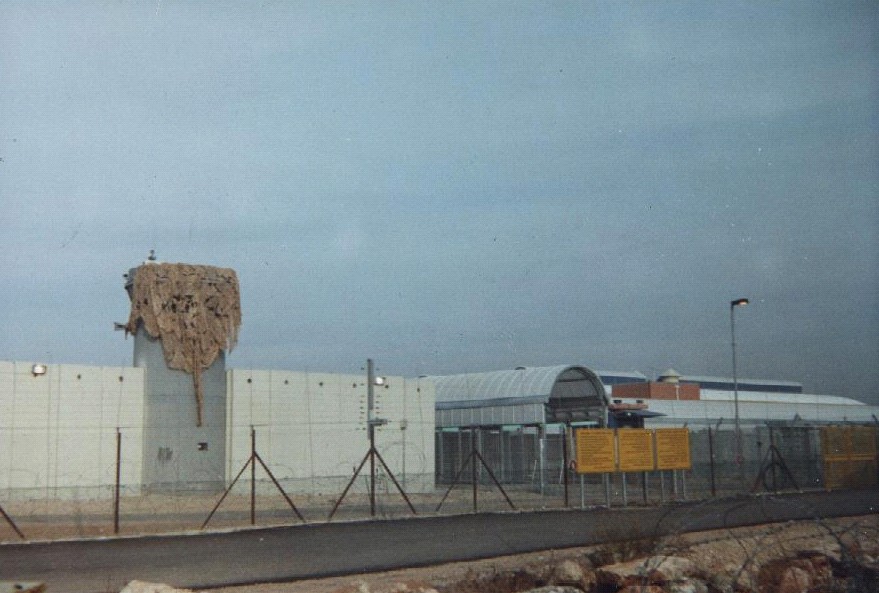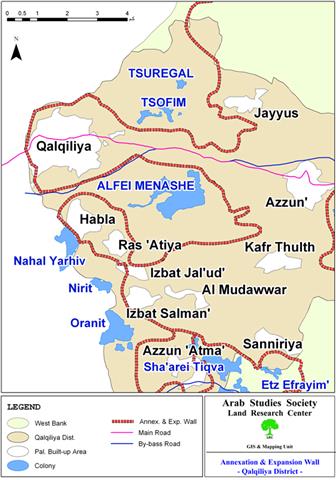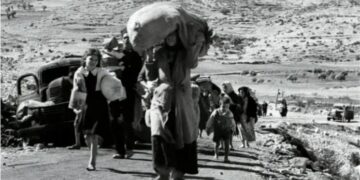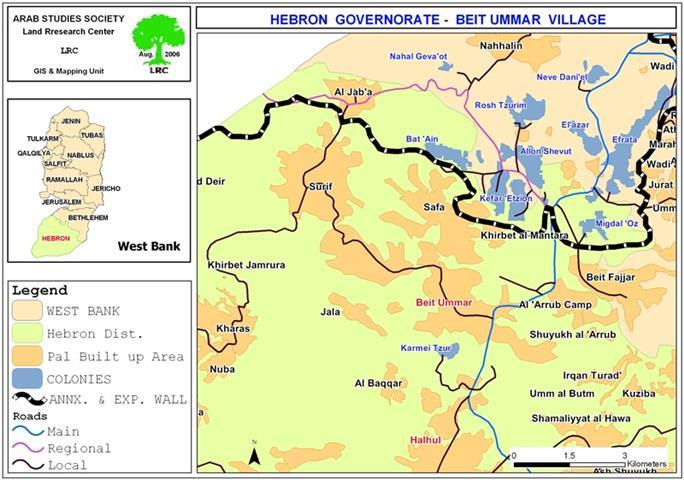Location and Population:
The city of Qalqilia is located in the northwestern part of the West Bank about 14 kilometers away from the Mediterranean Sea. It is situated atop the western water aquifer and is surrounded by more than 30 Palestinian villages. The current area of the city is about 12,500 dunums (in contrast to its pre-1948 War area as it lost about 40,000 dunums of its lands).
The population of the city of Qalqilia is around 45,000 Palestinians. As for the Governorate in general it has a population of 90,000 living in an area of 163 km2. See map 1

Map 1: Qalqiliya District
Economic Situation:
The city of Qalqilia is well known for its fertile lands that is planted with vegetables, Green Houses, olive trees, citrus trees and guava. It is worth pointing out that Qalqilia is the number one guava producer in the West Bank as well as being the number two producer of citrus crops (second only to Al Aghwar region) in the West Bank.
Israeli Control Plans in Qalqilia:
A) Militarily:
The unique location of the city of Qalqilia, its close proximity to the Sea and its proximity to the Villages of the Triangle (Al Tira, Al Tayba and Ras Al Ein) has made both the Governorate and the city of Qalqilia a prime target for Israeli control schemes. As such, Israeli authorities embarked since the late 70s on an intensified campaign of land confiscations and to surround the Governorate with a string of Israeli settlements such as the settlements of Zufin in the north, Alfe Minshe in the south, Karni Shomron in the east as well as the settlements of Oraniet, Sha'ari Tikva and Al Kana in the southern part of the Governorate.
B) Aquatic:
The lands of the Governorate of Qalqilia rest upon a famous Palestinian aquifer. As such Israeli authorities carried out the following actions as to deprive Palestinians of their own water sources. The actions include:
1. Israeli controlling measures in the field of agricultural are apparent as Israeli settlers control agricultural lands in Qalqilia as well as stealing Palestinian water sources in addition to the establishment of highly competitive and advanced agricultural techniques.
2. In the commercial field Israel has transformed the city of Qalqilia and its vicinity to an active market for Israeli products.
3. Cheep labor as Israelis took advantage
-
Preventing Palestinians from renovating or developing their wells along with denying any permission to dig new wells.
-
Placing water meters on the wells while setting a limit on how much water can be pumped.
-
Digging up 7 deep wells in the vicinity of Qalqilia and using high volume pumps that can pump up to 3,000 m3/hour which accounts to 20% of Israel??s water consumption needs.
C) Economic:
of the close proximity of Qalqilia to the Israeli proper and the shrinking of agricultural lands due to settlement expansion to open the doors for cheap Palestinian labor to access the Israeli work market. The number of Palestinian laborers crossing into Israel was about 19,000 on daily basis. Such a number has shrunk dramatically since the erection of the Israeli Racist Isolation Wall.
Israeli Violations in the Governorate of Qalqilia:
In addition to the establishment of the illegal settlements on the lands of the Governorate and confiscating water sources, Occupation Forces carried out the following violations:
1- The erection of the Israeli Racist Isolation Wall:
The Wall in Qalqilia is considered to be the worst and strangest; it is a cement Wall, 8 meters in height, surrounded by a series of ditches and refined roads for military jeep patrols. It also has a number of military towers and surrounds the Governorate of Qalqilia like a bracelet does to a wrist. The erection of the Wall has led to the following:
-
The length of Wall in Qalqilia is about 87 kilometers. To establish it about 4,000 dunums were confiscated while 80,000 trees were uprooted.
-
The Wall isolated about 55,000 dunums of fertile Palestinian lands. Some of these lands belonged to the villages of Jayyous, Filama and Azoun Al Atma.
-
The total isolation of 6 villages behind the Wall such as Azoun Al Atma, Ras Tira, Al Daba'a, Wad Rasha, Abu Qirda and Arab Al Ramadien Al Shamali.
-
The Wall has created a state of total disarray among the Palestinian communities in Qalqilia; the Palestinian farmer finds himself as a loss on how to access his land while teachers and students try to figure out how to access their schools. Employees and laborers became accustomed to ask questions about how to get to their workplace every morning. Such a state has led to the increase in the number and magnitude of social, psychological and demographical problems.
-
The closure of about 600 commercial shops.
-
The increasing difficulties in exporting Qalqilia's vegetable and fruit goods which led to millions of dollars in losses each year and contributed significantly to the staggering 65% unemployment rate.
2- The total enclosure of Qalqilia while leaving only one entrance point for its residents through the village of Nabi Ilyas. This means the if residents of the city of Qalqilia want to access their lands in the village of Habla (about 3 kilometers away) they would have to walk a distance of about 40 kilometers to reach their desired destination.
3- Israeli violations through the establishment of the so-called 'Leniency Measures' (Israeli measures designed to make Palestinian life easier). Israeli occupation forces established a tunnel connecting the southern villages with the city of Qalqilia. Yet, as it turned out, the opening and closing of this tunnel depends largely on the mood of the soldiers. Once the iron gates surrounding the tunnel are closed the village's of Qalqilia's southern part become totally isolated from the rest of the world.
As a result of the international pressure on Israel, occupation authorities established a passageway in the northern side of the city of Qalqilia. It is located on the road leading to the Triangle villages and was inaugurated in December 2005. It functions as an access point for merchants, workers and emergency medical cases from the Governorates of Salfeet and Qalqilia. According to Israeli claims, the passageway is scheduled to operate between 4:00 AM and 7:00 PM expect for Saturdays and Jewish holidays. The passageway is equipped to allow 300 persons per hour to access Israeli proper. Yet, on the ground data indicate that only 70 people are allowed to go through each hour due to the complex and humiliating treatment Palestinians have to go through on daily basis in the passageway which resembles to a great degree an animal pin; every person who enters the passageway has to go through lines surrounded by cement blocks and iron in addition to the metal detectors and a remote-controlled iron gate. Moreover, Israeli soldiers won't hesitate to shred the permission of any Palestinian who arrives to the passageway after 7:00 PM without giving him the chance to be issued another entrance permit.
As such, the so-called Israeli 'leniency measures' has developed into a set of newly-invented tools to humiliate and block the way of the Palestinians to whom the main question becomes how to cross the passageway. See photo 1& photo 2

A Genral Overview of the New Passage way

The checkpoint and barbed wires surrounding
Prepared by
The Land Research Center
LRC












